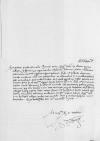Letter #220
Mercurino Arborio di GATTINARA to Ioannes DANTISCUSTordesillas, 1524-11-02
English register: Gattinara is returning Dantiscus’ memorandum to which he has added the emperor’s responses to the individual requests of the king [Sigismund I] and queen [Bona]. He advises the Polish envoy that as regards preparing the document of investiture requested by the queen [Bona], he should go to the secretary Pedro García. Gattinara, meanwhile, will try to come as soon as possible from Tordesillas [to Valladolid, where Dantiscus was]. He sends his regards to Dantiscus and his colleague [Stanisław Borek].
Manuscript sources:
Auxiliary sources:
Prints:
| ||||||||||
Text & apparatus & commentary Plain text Text & commentary Text & apparatus
Magnifico Domino
cf. Digesta 2, 14, 7, 7 Praetor ait pacta servabo Gattinara, a legal scholar, uses this abridged quotation from Justinian’s Digest as a proverbial statement of the obligation to honor one’s engagements ⌊Ait praetor: pacta servabocf. Digesta 2, 14, 7, 7 Praetor ait pacta servabo Gattinara, a legal scholar, uses this abridged quotation from Justinian’s Digest as a proverbial statement of the obligation to honor one’s engagements ⌋.
Promisi enim, Magnifice Domine, in ultimo nostro colloquio, quod quamprimum a regio consilio relationem haberem, statim responderetur petitionibus
Valeat interea Magnificentia Vestra cum reverendo domino
Ex
Ad mandata Magnificentiae Vestrae deditus
[1 ] The whole memorandum and replies mentioned here are lost, perhaps one paragraph has been preserved, cf. cf.

